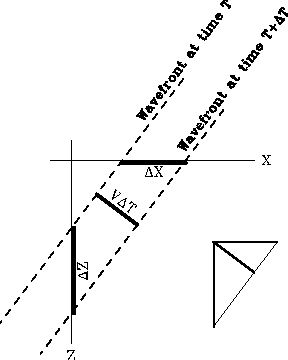




Next: Implementation
Up: ADDING ANISOTROPY
Previous: ADDING ANISOTROPY
The isotropic eikonal equation is
|  |
(1) |
where  gives the traveltime of some event at each point in space,
and s(x,z) gives the slowness (inverse velocity) at each point in space.
Van Trier and Symes (1990) start from this equation (equation (1) in their
paper) and derive a traveltime extrapolation equation.
gives the traveltime of some event at each point in space,
and s(x,z) gives the slowness (inverse velocity) at each point in space.
Van Trier and Symes (1990) start from this equation (equation (1) in their
paper) and derive a traveltime extrapolation equation.
What does equation (1) represent?
Figure 1 shows a tiny portion of a wavefront
at two closely-spaced instants in time.
On this scale, the wavefront can be approximated as a plane wave.
The plane wave is moving along in some arbitrary direction
with a velocity V, so
it travels a distance  between the two times.
At the same time, the plane wave also moves a
distance
between the two times.
At the same time, the plane wave also moves a
distance  along the X axis
and
along the X axis
and  along the Z axis.
along the Z axis.
planar
Figure 1
Geometrical properties of plane-wave propagation.

The triangle to the lower right of Figure 1 has sides of length
 and
and  meeting at a right angle, and a height of
meeting at a right angle, and a height of
 (if the hypotenuse is considered the base).
Three applications of Pythagoras' theorem (one for each of the three
right triangles involved) and a little algebra show that
(if the hypotenuse is considered the base).
Three applications of Pythagoras' theorem (one for each of the three
right triangles involved) and a little algebra show that
|  |
(2) |
and thus
|  |
(3) |
Hence, equation (1) does have a simple geometrical meaning.
How do we make equation (1) anisotropic?
From the previous two paragraphs, we can see that
 in equation (1)
(or
in equation (1)
(or  in equation (3))
is just the horizontal phase slowness. For a monochromatic
plane wave this is
in equation (3))
is just the horizontal phase slowness. For a monochromatic
plane wave this is  .Similarly,
.Similarly,
 .This lets us rewrite equation (1)
as a dispersion relation:
.This lets us rewrite equation (1)
as a dispersion relation:
|  |
(4) |
(This is just the Fourier-transformed homogeneous wave equation.
Fourier-transformation breaks the wavefield up into plane-wave components.)
Recast as a dispersion relation, F(u) in equation (4) of
Van Trier and Symes has a simple
interpretation: u is a horizontal phase slowness  , and
F(u) is a vertical phase slowness
, and
F(u) is a vertical phase slowness  .Replacing the isotropic dispersion relation in their paper
with an appropriate anisotropic
one gives an anisotropic traveltime extrapolation equation.
Unfortunately, solving for kz as a function of kx can be difficult
for some anisotropic media. In the general case of arbitrary three-dimensional
anisotropy it can require solving a sixth order polynomial.
.Replacing the isotropic dispersion relation in their paper
with an appropriate anisotropic
one gives an anisotropic traveltime extrapolation equation.
Unfortunately, solving for kz as a function of kx can be difficult
for some anisotropic media. In the general case of arbitrary three-dimensional
anisotropy it can require solving a sixth order polynomial.





Next: Implementation
Up: ADDING ANISOTROPY
Previous: ADDING ANISOTROPY
Stanford Exploration Project
1/13/1998
![]() between the two times.
At the same time, the plane wave also moves a
distance
between the two times.
At the same time, the plane wave also moves a
distance ![]() along the X axis
and
along the X axis
and ![]() along the Z axis.
along the Z axis.

![]() and
and ![]() meeting at a right angle, and a height of
meeting at a right angle, and a height of
![]() (if the hypotenuse is considered the base).
Three applications of Pythagoras' theorem (one for each of the three
right triangles involved) and a little algebra show that
(if the hypotenuse is considered the base).
Three applications of Pythagoras' theorem (one for each of the three
right triangles involved) and a little algebra show that

![]() in equation (1)
(or
in equation (1)
(or ![]() in equation (3))
is just the horizontal phase slowness. For a monochromatic
plane wave this is
in equation (3))
is just the horizontal phase slowness. For a monochromatic
plane wave this is ![]() .Similarly,
.Similarly,
![]() .This lets us rewrite equation (1)
as a dispersion relation:
.This lets us rewrite equation (1)
as a dispersion relation:
![]() , and
F(u) is a vertical phase slowness
, and
F(u) is a vertical phase slowness ![]() .Replacing the isotropic dispersion relation in their paper
with an appropriate anisotropic
one gives an anisotropic traveltime extrapolation equation.
Unfortunately, solving for kz as a function of kx can be difficult
for some anisotropic media. In the general case of arbitrary three-dimensional
anisotropy it can require solving a sixth order polynomial.
.Replacing the isotropic dispersion relation in their paper
with an appropriate anisotropic
one gives an anisotropic traveltime extrapolation equation.
Unfortunately, solving for kz as a function of kx can be difficult
for some anisotropic media. In the general case of arbitrary three-dimensional
anisotropy it can require solving a sixth order polynomial.